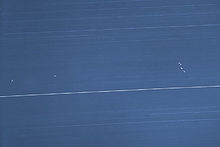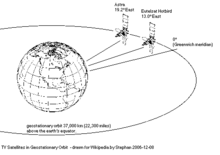SES Astra
The SES ASTRA SA , based in Betzdorf in Luxembourg is a subsidiary of the satellite operator SES SA and operates a fleet of geostationary broadcasting and communication satellites . Until 2011, SES ASTRA was also responsible for the commercial and technical marketing of the ASTRA satellites; this was transferred to the management of SES SA in May 2011.
The name ASTRA ( Latin astrum 'star') and the associated logo are currently still used as a trademark by SES SA and continue to be used to name some of the satellites in the SES fleet. SES SA operates a subsidiary ASTRA Deutschland GmbH based in Unterföhring near Munich for the marketing of its services in German-speaking countries . It was headed by Wolfgang Elsäßer from 2004 to 2016.
purpose
The SES Astra satellites are primarily used for direct reception of satellite broadcasting with a mostly 60 to 90 cm large parabolic antenna , also known as a satellite dish . This means that over 2500 digital TV and radio channels can be received via 242 transponders from over 142 million households in Europe . Astra's principle of co-positioning , in which several satellites are arranged close to one another within a cube with an edge length of 150 km, enables all frequencies of the Ku band to be used in one orbital position - which is currently not possible with just one satellite. In addition, reserve transponders from other satellites can quickly take over the transmission if a satellite breaks down.
history
In March 1985 the Société Européenne des Satellites (SES SA) was founded with the aim of commercializing a communications satellite called ASTRA for direct reception with small parabolic antennas. This should be made possible by the rapidly advancing technical development in LNB technology, which allowed private households to practice direct reception from low-power (20 watts per transponder) post telecommunication satellites with relatively handy satellite dishes with a diameter of only 1.2 meters.
It was a logical conclusion of the SES that through the use of modern satellites with an EIRP of 51 dBW the necessary dish size could be reduced to a format of 75 cm and less that was really suitable for mass use for the first time.
Due to the failure of the satellite TV-Sat 1 on November 21, 1987 (a solar panel of the TV-Sat could not be unfolded) the time bonus of the state direct satellite was lost and the way for the market success of the Astra 1A launched on December 11, 1988 was clear. TV-Sat 2 started on August 8, 1989, but this turned out to be too late.
After the success of the ASTRA satellite became apparent shortly after its commissioning in February 1989, SES decided to build another satellite and launch it into orbit. SES relied on a technical innovation: Astra 1B was launched in March 1991 and maneuvered to the same orbital position as ASTRA 1A (19.2 ° East at approx. 36,000 km above the equator). By using a frequency range adjacent to ASTRA 1A, the number of television channels could be increased from 16 to 32 transponders.
The ASTRA satellite system was expanded between 1993 and 1999 by a further six satellites (ASTRA 1C-1H) by copositioning to 19.2 ° East. As a result, the entire Ku band between 10.7 and 12.75 GHz was used in the downlink and a total of 120 transponders (of which 64 were analog and 56 digital transponders) were offered. Specially designed transponders are usually used for digital transmission. ("In principle, old analog transponders can also be used digitally, but usually fewer programs are transmitted than with newer transponders and the footprint is smaller.") In 1998, another orbital position was opened at 28.2 ° East, but this was an agreement between SES and the competing satellite operator Eutelsat, as it already used frequency ranges at 28.5 ° East.
In the years 1998 to 2001 SES SA took over shares in other satellite operators (including NSAB, Embratel and GE Americom). As a consequence, SES Global was founded in 2001 as a holding company and SES ASTRA SA as a subsidiary. In 2011 the operational separation between SES and SES ASTRA was lifted.
Orbital positions of the active satellites
| 19.2 ° East | 28.2 ° East | 23.5 ° East | 5.0 ° East | 31.5 ° East |
|---|---|---|---|---|
| Astra 1KR | Astra 2E | Astra 3B | Astra 4A | Astra 5B |
| Astra 1L | Astra 2F | |||
| Astra 1M | Astra 2G | |||
| Astra 1N |
Co-positioned satellites
| 19.2 ° East | 28.2 ° East | 23.5 ° East | 5.0 ° East | 31.5 ° East |
|---|---|---|---|---|
| SES-5 |
Currently, the positions 19.2 ° East and 28.2 ° East are mostly important for direct reception. The satellites at 19.2 ° East are aimed at continental Europe with a very high proportion of German channels and some channels in other European languages such as French, Spanish, Italian, English and Polish. The satellites at 28.2 ° East are directed against it to the needs of the UK, especially with the BSB - pay-TV and the transmitters of the BBC .
Until April 2011, the German cable network operators supplied the signals for the cable head-end stations in encrypted form via Astra 3, as there was no area-wide fiber optic network. Due to the lack of space at 19.2 ° East, Astra 3 is gradually to become the main position for Dutch channels, which is why parts of the Dutch Canal Digitaal bouquet as well as all regional channels are broadcast over 23.5 ° East.
Antenna alignment for satellite position 19.2 ° East

The Astra satellite position 19.2 ° East, which is of the greatest importance for the German-speaking area, is stationary 36,000 km above the equator . Therefore a satellite dish in Central Europe has to deviate slightly from the south to the east ( azimuth angle ) and be directed slightly upwards ( elevation angle ). The following elevation values and azimuth angles apply to the Astra satellites at 19.2 ° East (see also: Horizontal angle ):
| place | Elevation / inclination angle (°) (0 ° = horizon, 90 ° = zenith) |
Azimuth / horizontal angle (°) (90 ° = east, 180 ° = south) |
|---|---|---|
| Kiel | 27.5 | 168.9 |
| Rostock | 27.9 | 171.3 |
| Hamburg | 28.3 | 168.6 |
| Berlin | 29.7 | 172.7 |
| Bochum | 30.3 | 164.7 |
| Bremen | 28.6 | 167.0 |
| Hanover | 29.5 | 168.1 |
| Dusseldorf | 30.2 | 164.2 |
| kassel | 30.6 | 167.6 |
| Dresden | 31.3 | 173.0 |
| Mainz / Wiesbaden | 31.6 | 165.9 |
| Nuremberg | 32.8 | 169.4 |
| Saarbrücken | 32.3 | 164.1 |
| Stuttgart | 33.2 | 166.8 |
| Vienna (A) | 34.5 | 176.2 |
| Munich | 34.2 | 169.8 |
| Zurich (CH) | 34.6 | 165.7 |
The elevation and azimuth angles can be calculated using formulas for any satellite and any receiving location (see: Geostationary satellite ).
Special services
Some of the satellites are equipped with special technologies, for example with
- Skyplex , a multiplex method for satellites
- Satmode , an interactive television service
- Entavio digital platform
See also
literature
- Wilfried Ahrens: ASTRA - television without borders: Eine Chronik , Econ Verlag , Düsseldorf, Vienna, New York, Moscow (1993) ISBN 3-430-11008-4 .
- Gernot Busch: The introduction of direct satellite reception in Germany via ASTRA , VISTAS Verlag, Berlin (2009) ISBN 978-3-89158-495-8 .
- Chris Forrester: High Above - The untold story of Astra, Europe's leading satellite company , Springer Berlin Heidelberg (2011), 242 pages. ISBN 978-3-642-12009-1 .
Web links
- Astra Home German
- Astra Home engl.
- Current orbit positions of the Astra satellites
- Station lists of the programs broadcast on Astra 19.2 ° East
- SES - Satellites Fleet in Google Earth
Individual evidence
- ↑ Quoted from ten Haaft GmbH: General information on satellite technology ( Memento of the original from October 23, 2014 in the Internet Archive ) Info: The archive link was inserted automatically and has not yet been checked. Please check the original and archive link according to the instructions and then remove this notice. Retrieved October 18, 2014.






